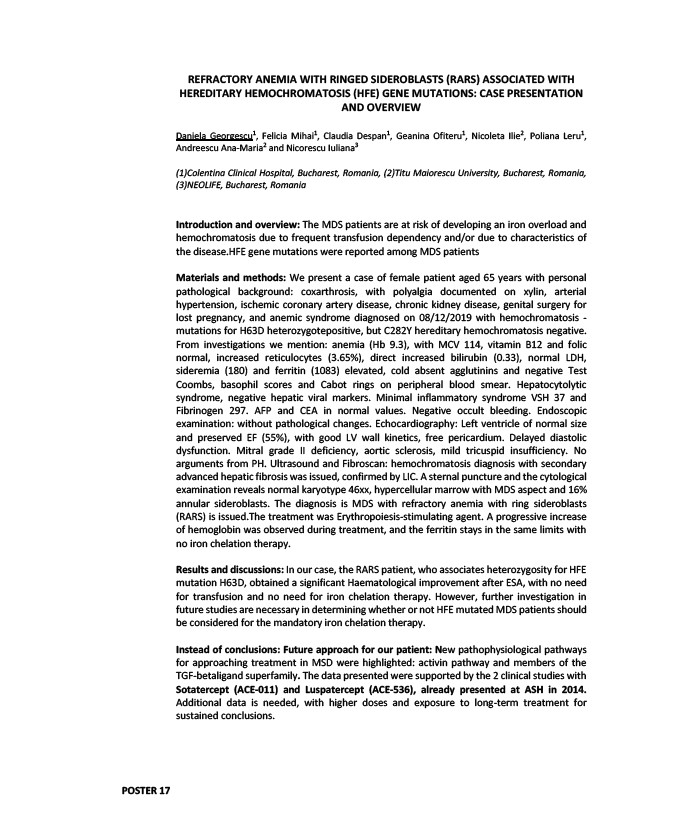
REFRACTORY ANEMIA WITH RINGED SIDEROBLASTS (RARS) ASSOCIATED WITH
HEREDITARY HEMOCHROMATOSIS (HFE) GENE MUTATIONS: CASE PRESENTATION
AND OVERVIEW
Daniela Georgescu1, Felicia Mihai1, Claudia Despan1, Geanina Ofiteru1, Nicoleta Ilie2, Poliana Leru1,
Andreescu Ana-Maria2 and Nicorescu Iuliana3
(1)Colentina Clinical Hospital, Bucharest, Romania, (2)Titu Maiorescu University, Bucharest, Romania,
(3)NEOLIFE, Bucharest, Romania
Introduction and overview: The MDS patients are at risk of developing an iron overload and
hemochromatosis due to frequent transfusion dependency and/or due to characteristics of
the disease.HFE gene mutations were reported among MDS patients
Materials and methods: We present a case of female patient aged 65 years with personal
pathological background: coxarthrosis, with polyalgia documented on xylin, arterial
hypertension, ischemic coronary artery disease, chronic kidney disease, genital surgery for
lost pregnancy, and anemic syndrome diagnosed on 08/12/2019 with hemochromatosis -
mutations for H63D heterozygotepositive, but C282Y hereditary hemochromatosis negative.
From investigations we mention: anemia (Hb 9.3), with MCV 114, vitamin B12 and folic
normal, increased reticulocytes (3.65%), direct increased bilirubin (0.33), normal LDH,
sideremia (180) and ferritin (1083) elevated, cold absent agglutinins and negative Test
Coombs, basophil scores and Cabot rings on peripheral blood smear. Hepatocytolytic
syndrome, negative hepatic viral markers. Minimal inflammatory syndrome VSH 37 and
Fibrinogen 297. AFP and CEA in normal values. Negative occult bleeding. Endoscopic
examination: without pathological changes. Echocardiography: Left ventricle of normal size
and preserved EF (55%), with good LV wall kinetics, free pericardium. Delayed diastolic
dysfunction. Mitral grade II deficiency, aortic sclerosis, mild tricuspid insufficiency. No
arguments from PH. Ultrasound and Fibroscan: hemochromatosis diagnosis with secondary
advanced hepatic fibrosis was issued, confirmed by LIC. A sternal puncture and the cytological
examination reveals normal karyotype 46xx, hypercellular marrow with MDS aspect and 16%
annular sideroblasts. The diagnosis is MDS with refractory anemia with ring sideroblasts
(RARS) is issued.The treatment was Erythropoiesis-stimulating agent. A progressive increase
of hemoglobin was observed during treatment, and the ferritin stays in the same limits with
no iron chelation therapy.
Results and discussions: In our case, the RARS patient, who associates heterozygosity for HFE
mutation H63D, obtained a significant Haematological improvement after ESA, with no need
for transfusion and no need for iron chelation therapy. However, further investigation in
future studies are necessary in determining whether or not HFE mutated MDS patients should
be considered for the mandatory iron chelation therapy.
Instead of conclusions: Future approach for our patient: New pathophysiological pathways
for approaching treatment in MSD were highlighted: activin pathway and members of the
TGF-betaligand superfamily. The data presented were supported by the 2 clinical studies with
Sotatercept (ACE-011) and Luspatercept (ACE-536), already presented at ASH in 2014.
Additional data is needed, with higher doses and exposure to long-term treatment for
sustained conclusions.
POSTER 17